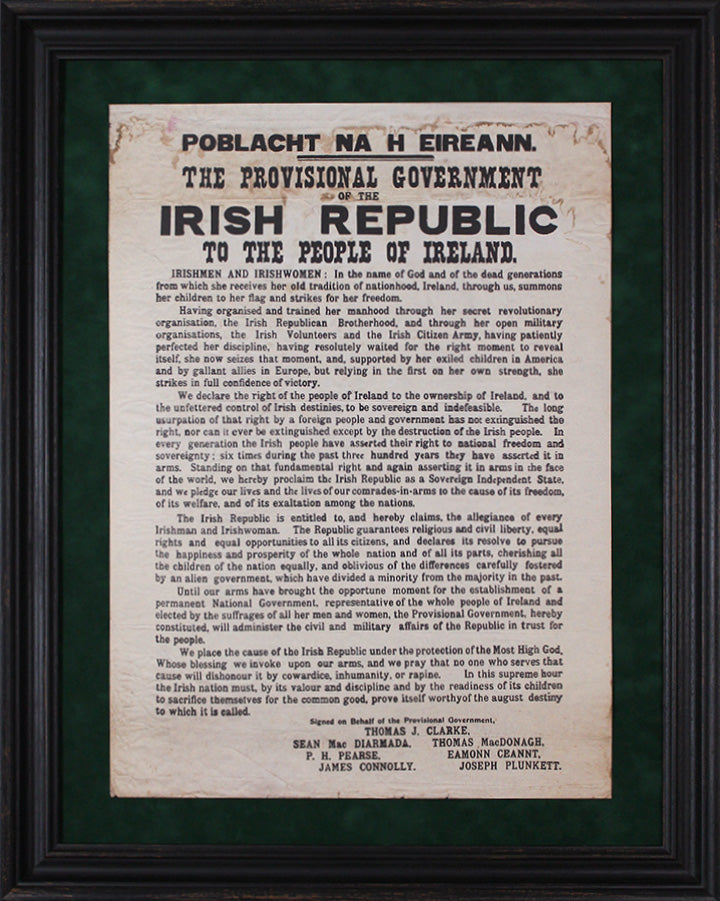The Walton Collection
1916 Copy of Proclamation of the Irish Republic (Limited Edition)
1916 Copy of Proclamation of the Irish Republic (Limited Edition)
Couldn't load pickup availability
A rare 1916 Copy of the Proclamation of the Irish Republic. We believe from the information available that this is one of the earliest known reproductions of the original Proclamation which was most likely reproduced either during, or in the weeks following, the Rising of 1916. In its typography, it is identical to the half-size versions in the O'Hegarty Collection (Kansas University) and The Walton Collection and closer to the original Proclamation than either of the copies produced in the Sinn Féin Handbook in August 1916 and the ICA copy production in Easter 1917, or indeed any subsequent copies. In tandem with the half-size copy, with which it was discovered in The Walton Collection, this raises new questions around the history of copies of the Proclamation. Separately, it is a beautiful document in its own right and will create many talking points, highlighting as it does the whole remarkable story of how the Proclamation was printed and its many charming flaws.
This unique 250 limited edition Proclamation copy is reproduced on 260 GSM water colour paper and is mounted on a mottled pine green suede backing which is set behind glass in an aged black wood mahogany style and handmade frame. Each Proclamation comes with a numbered certificate of Limited Edition from The Walton Collection and a printout of the full historical notes.
Brief Historical Note:
There are a number of fascinating details about this unique copy of the iconic 1916 Proclamation. For much of this detail I have relied on the remarkable research carried out by James Mosley and published on his TypeFounder blog in 2010 (details below). Mosley, who was an expert in the history of typefoundry has bought a new and keen print historian's eye to the evolving history of the Proclamation however he was not aware, when writing his findings, of the existence this version which appears to be another unique copy of the Proclamation, most likely printed shortly after or during the Rising.
Regrettably I have been unable to contact James Mosley and given he was elderly on his last visit to Dublin in 2010 from the UK where he lived I can only assume that sadly he is no longer with us. But his excellent work and research is, so for two fascinating reads of Mosley's Blogs on "The Image of the Proclamation of the Republic 1916"
Most notably, writing in 2010, Mosley states that "The inevitable conclusion is that the ‘reprint of 1917’ was not printed from reset typecase at all but was produced by means of a photographic process, either a line block or (perhaps more likely in this case, given the size of the sheet) photolithography. The "improvement" to this image is similar to that of the Sinn Fein Rebellion Handbook: a redrawn 'E' is substituted for the adapted 'F', the damaged 'R' of IRISH is repaired and, as noted above, the inverted 'e' in the sixth paragraph is corrected, making this the only known reproduction of the Proclamation in which this was done. The 'M' in the name of Eamonn Ceannt among the signatures, obscured by dirt in the original printing, is mistakenly retouched as 'N'. All the variable spacing of the original is exactly reproduced, and the wrong-fount letters of the original are all in their places. The questions that are raised concerning Bouch’s own account of this version are hardly worth pursuing at length, since no original copy is known to survive today."
At the time of writing Mosley was not aware of The Walton Collection and the two, identical (in print typography) but variant in size copies which were found together. I believe, that based on Mosley's expert assertions, and that my grandfather’s copy does not have the corrected inverted 'e' or a wrongly touched up 'M' of the 1917 copy, and nor does it have the corrections to the indented decorative 'O's' of the Sinn Féin Handbook version of August 1916 , it is reasonable to assume that this copy predates these copies, and was corrected and touched up for printing entirely independently of those copies.
See below extract from Bouch's 1936 book based on interviews with those who printed the original proclamation.Bouch is historcally considered an authority on the story of the Proclamation but until now we had no accessibe samples of the smaller sizes proclamations he refers to below however we now have two smaller-sized versions as this version is 625 mm x 450 mm , about 15% smaller in height and width than the original Proclamation :

Putting these observations together this copy was therefore most likely printed either during, or in the weeks shortly after, the Rising in 1916.
If you would like a free and more lengthy typographical explanation and background on our copies email info@thewaltoncollection.ie . I also welcome any additional information or observations interested parties can provide.




